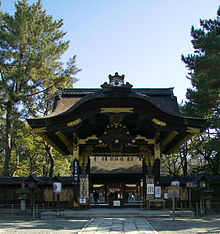| Toyokuni Shrine 豊国神社 | |
|---|---|
 Karamon gate at entrance to Toyokuni Shrine Karamon gate at entrance to Toyokuni Shrine | |
| Religion | |
| Affiliation | Shinto |
| Deity | Toyotomi Hideyoshi |
| Location | |
| Location | 530 Chaya-chō, Shōmen-dōri, Yamato-ōdōri, Higashiyama-ku, Kyōto-shi, Kyōto-fu |
 | |
| Geographic coordinates | 34°59′29″N 135°46′21″E / 34.99139°N 135.77250°E / 34.99139; 135.77250 |
| Architecture | |
| Date established | 1599; 426 years ago (1599) |
Toyokuni Shrine (豊国神社, Toyokuni-jinja) is a Shinto shrine located in Higashiyama-ku, Kyoto, Japan. It was built in 1599 to commemorate Toyotomi Hideyoshi. It is the location of the first tamaya (a Shinto altar for ancestor worship) ever constructed, which was later destroyed by the Tokugawa clan.
History
This shrine is the official tomb and shrine of Toyotomi Hideyoshi, who died on September 18, 1598, in Kyoto.
Nobles, priests, warriors, and townspeople gathered at the shrine to celebrate the anniversary of Hideyoshi's apotheosis with banquets, musical recitals, and boisterous festivity. The shrine was closed by Tokugawa Ieyasu in June 1615 "to discourage these unseemly displays of loyalty to a man he had eclipsed."
The Meiji Emperor directed that the shrine be restored in Keiō 4, the 6th day of the 6th month (April 28, 1868). At that time, the shrine area was expanded slightly by encompassing a small parcel of land which had been part of the adjacent Hōkō-ji.
In 1897, the tercentenary of Hideyoshi was celebrated at this site.
Architecture
It is generally believed that the karamon gate was originally built for Hideyoshi's Fushimi castle in 1598. When the castle was dismantled in 1623, the gate was first moved to Nijō castle, and then to the Konchi-in in Nanzen-ji. It was finally relocated to Toyokuni shrine in 1876 after the Meiji Restoration.
Designated Cultural Properties
National Treasures of Japan
- The karamon
Important Cultural Properties
- Painted folding screen depicting Festivals of Toyokuni (豊国の祭り), by Kanō Naizen of the Kanō School
- Vest garment decorated with gold Chrysanthemum motif
- Three decorated Chinese-style chests
- Iron lantern cage
- Naginata blade Honebami ("Bone-eater"), unsigned, attributed to Awataguchi Yoshimitsu
Gallery
-
 The front shrine and main hall
The front shrine and main hall
-
 Roof
Roof
-
 Ema
Ema
-

See also
- Toyotomi Hideyoshi
- Mimizuka: a nose tomb containing the noses of Korean and Chinese people killed during the invasion of Korea
Notes
- "reibyou 霊廟". Japanese Architecture and Art Net Users System. 2001. Retrieved 2007-08-09.
- Ponsonby-Fane, R. (1956). Kyoto: the Old Capital City, 794-1869, pp. 294-296.
- Berry, Mary E. (1982). Hideyoshi. pp. 1.
- Ponsonby-Fane, p. 327.
- Ponsonby-Fane, p. 294.
- Ponsonby-Fane, p. 296.
- Kirby, John B. (1962). From Castle to Teahouse: Japanese Architecture of the Momoyama Period. pp. 76-77.
- "Fushimi castle". Guide to Japan Castles. Retrieved 2018-09-26.
- Kirby, John B. (1962). From Castle to Teahouse: Japanese Architecture of the Momoyama Period. pp. 76-77.
References
- Ponsonby-Fane, Richard A. B. (1956). Kyoto: The Old Capital of Japan, 794-1869. Kyoto: The Ponsonby Memorial Society.
- Berry, Mary Elizabeth. (1982). Hideyoshi. Cambridge: Harvard University Press. ISBN 0-674-39026-1 (cloth, 1982), ISBN 0-674-39026-1 (paper, 1989) (scholarly biography)
- Kirby, John B. (1962). From Castle to Teahouse: Japanese Architecture of the Momoyama Period. Tokyo: Tuttle Publishing. OCLC 512972
| Shinto shrines | |||||||||||||||||||||||||||||
|---|---|---|---|---|---|---|---|---|---|---|---|---|---|---|---|---|---|---|---|---|---|---|---|---|---|---|---|---|---|
| |||||||||||||||||||||||||||||
| |||||||||||||||||||||||||||||